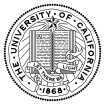University of California, Davis: Difference between revisions
m Reverted edits by 169.199.224.1 to last version by Andrewlp1991 (HG) |
→Campus: linking to wikipedia article |
||
| Line 63: | Line 63: | ||
The Tercero undergraduate housing complex is located near the true geographic center of the UC Davis campus, to the north of the beautiful Aboretum Waterway, which stretches longitudinally through almost the entirety of the south end of campus. The [[University of California, Davis, Arboretum|Arboretum]] is a public garden with over 4,000 kinds of trees and plants that stretches for over 100 acres (.40 square km) and located near the Waterway. |
The Tercero undergraduate housing complex is located near the true geographic center of the UC Davis campus, to the north of the beautiful Aboretum Waterway, which stretches longitudinally through almost the entirety of the south end of campus. The [[University of California, Davis, Arboretum|Arboretum]] is a public garden with over 4,000 kinds of trees and plants that stretches for over 100 acres (.40 square km) and located near the Waterway. |
||
The majority of Veterinary Medicine, Equestrian Center, and Animal Sciences buildings are located near the Arboretum Waterway, away from the core campus; the West Entry Parking Complex, the Silo Union, and the newly constructed Science Lecture Hall and the Science Laboratory Building are located nearer to the Tercero residence halls and the core of campus. The Mondavi Center, home of the University Symphony Orchestra and other cultural events, is also located near the Tercero complex. |
The majority of Veterinary Medicine, Equestrian Center, and Animal Sciences buildings are located near the Arboretum Waterway, away from the core campus; the West Entry Parking Complex, the Silo Union, and the newly constructed Science Lecture Hall and the Science Laboratory Building are located nearer to the Tercero residence halls and the core of campus. The [[Mondavi Center]], home of the University Symphony Orchestra and other cultural events, is also located near the Tercero complex. |
||
[[Image:Davis-head-statue.jpg|thumb|left|See No Evil/Hear No Evil Egghead]] |
[[Image:Davis-head-statue.jpg|thumb|left|See No Evil/Hear No Evil Egghead]] |
||
Revision as of 10:48, 15 November 2008
| File:UniversityofCalifornia,Davis.JPG | |
Former names | University Farm (1905-22) Northern Branch of the College of Agriculture (1922-59) |
|---|---|
| Motto | Fiat lux (Latin) |
Motto in English | Let there be light |
| Type | Public, Land-grant, Space-grant |
| Established | 1905 as the University Farm 1959 established as a general UC campus |
| Endowment | US $651 million[1] |
| Chancellor | Larry N. Vanderhoef |
Academic staff | 2,091 |
| Undergraduates | 23,458[2] |
| Postgraduates | 7,017[2] |
| Location | , , |
| Campus | Rural, 5,300 acres (21 km²) |
| Newspaper | The California Aggie |
| Colors | Aggie Blue and Gold |
| Nickname | Aggies |
| Affiliations | University of California AAU Big West Conference Great West Conference |
| Mascot | Gunrock the Mustang |
| Website | www.ucdavis.edu |
The University of California, Davis, commonly known as UC Davis, or just UCD, is a public, coeducational university located in the city of Davis, California. UC Davis is one of the ten campuses of the University of California, established originally in 1905 as the University Farm (extension of UC Berkeley). It was later formally established as a UC campus by the Regents of the University of California in 1959.
UC Davis has grown to become a prestigious public research university, especially in the arts, humanities, environmental science, life and health sciences, agricultural science and engineering disciplines. UC Davis also has renowned graduate programs, such as the UC Davis School of Medicine (which includes the UC Davis Medical Center), the UC Davis School of Veterinary Medicine, the UC Davis School of Law, UC Davis Graduate Studies, and the UC Davis Graduate School of Management.
Washington Monthly ranks UC Davis 8th in the United States.[3] U.S. News & World Report 2009 America's Best Colleges ranked UC Davis the 44th best "national university" in the United States and the 12th best public university in the United States.[4] UC Davis is also a Public Ivy.[5]
In addition to research and academics, UC Davis has a noteworthy athletics program; Aggie teams have recently joined NCAA Division I athletics. In its first year of full Division I status, 11 UC Davis teams qualified for NCAA post-season. Most of UC Davis's athletics teams play in the Big West Conference, but some (for the sports that the Big West Conference does not sponsor) also compete in the Great West Conference, Pacific-10 Conference, and the Mountain Pacific Sports Federation.
History
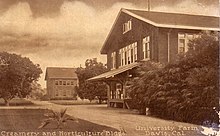
In 1905, Governor George Pardee signed into law an act to establish a university farm school for the University of California (at the time, the Berkeley campus was the sole campus of the University). It would be more than a year before that commission selected a tiny town, then known as Davisville, as the site. What was to become the third UC Campus opened its doors to 40 degree students (all male) from UC Berkeley in January 1909 as the "University Farm." (The farm had begun accepting non-degree farmers' short courses in October of 1908; there were initially around 115 such attendees.) The establishment of the Farm was largely the result of the vision and perseverance of Peter J. Shields, secretary of the State Agricultural Society, and the namesake of the future Peter J. Shields Library at UC Davis.
Shields began to champion the cause of a University Farm to teach agriculture in a more applied fashion after hearing about California students who chose to go to out-of-state universities due to the lack of such programs in the University of California at that time. He later stated:
There was a College of Agriculture at Berkeley in connection with the University of California, but it was purely academic. It was largely confined to the study of botany and chemistry; it had no farm and little prestige; it was apt to be thought of as a snap curriculum, attracting students who wanted to go to college but wanted to avoid its more difficult work.
After two failed bills, a law authorizing the creation of a University Farm was passed in March 18, 1905, and Yolo County, home to some of California's prime farmland, was chosen as the site. The Farm accepted its first female students in 1914 from Berkeley. Renamed in 1922 the Northern Branch of the College of Agriculture, it continued growing at a breakneck pace: in 1916 the Farm's 314 students occupied the original 778 acre (3 km²) campus, but by 1951 it had already expanded to a size of 3,000 acres (12 km²). In 1959, the campus was declared by the Regents of the University of California as the seventh general campus in the University of California system. It has since grown into a vibrant and politically active campus.
Campus

The University of California, Davis campus is the largest campus in the UC system, spanning over 5,500 acres (22.3 km2) across two counties: Yolo and Solano. Located 15 miles (24.1 km) west of Sacramento in the Sacramento Valley, part of California's Central Valley it is adjacent to Interstate Highway 80. The Davis campus is the only school within the UC system with an airport, just west of main campus, and is one of two UC schools with its own fire department; the other being UCSC. It is also one of only two schools in the University of California system, the other being UC Berkeley, with a nuclear lab.

The UC Davis campus is considered world-renowned and has been praised for its architecture and picturesque scenery. UC Davis offers broad green lawns and bubbling fountains, sculpture gardens and fine museums, lush landscaping and an intriguing mix of architectural styles. There are huge amounts of well-kept and attractive open space on the UC Davis campus, from Hutchison, Dobbins, Russell, and Howard Fields to various soccer, rugby, lacrosse, and tennis fields. It is surrounded by the residential area of the city of Davis.
Towards the northeast end of campus is the Quad, a large rectangular field which sits adjacent to Freeborn Hall and the Memorial Union, which houses various establishments such as the UC Davis Bookstore, ASUCD Coffee House, food courts, Post Office, Sky Room, and the MU Games Area. The northeast side of campus holds more of the core buildings that were built earlier in UC Davis's history, such as Wellman Hall, Shields Library, Mrak Hall, and Hutchison Hall, as well as the North Entry Parking Structure.
The northwest end of campus holds the majority of the Segundo undergraduate housing complex and various alternative non-undergraduate housing such as Orchard Park, Russell Park, and The Colleges at LaRue Apartments. The Activities and Recreation Center, or the ARC, is also located near the Segundo complex. Off-campus to the northwest is the Cuarto undergraduate housing complex, which has two dining commons.

The Tercero undergraduate housing complex is located near the true geographic center of the UC Davis campus, to the north of the beautiful Aboretum Waterway, which stretches longitudinally through almost the entirety of the south end of campus. The Arboretum is a public garden with over 4,000 kinds of trees and plants that stretches for over 100 acres (.40 square km) and located near the Waterway.
The majority of Veterinary Medicine, Equestrian Center, and Animal Sciences buildings are located near the Arboretum Waterway, away from the core campus; the West Entry Parking Complex, the Silo Union, and the newly constructed Science Lecture Hall and the Science Laboratory Building are located nearer to the Tercero residence halls and the core of campus. The Mondavi Center, home of the University Symphony Orchestra and other cultural events, is also located near the Tercero complex.
There are five public art statues found around campus, collectively called The Egghead Series, sculpted by former art professor Robert Arneson who taught at Davis from 1962-1991 before his death in 1992. The egghead statues are considered by many to be among the most recognizable features of UC Davis's campus, and have even inspired a recent blog maintained by University staff. Additional pieces of Arneson's work are part of the Fine Arts Collection maintained by the Richard L. Nelson Gallery located in the Art Building.
"Bookhead" is located at the Shields Library plaza, "Yin & Yang" is located at the Fine Arts Complex, "See No Evil/Hear No Evil" is at the east lawn of King Hall (the main building for UC Davis' School of Law), "Eye on Mrak (Fatal Laff)" is outside Mrak Hall (housing the registrar office and other administrative offices), and "Stargazer" is located between North Hall and Young Hall. The "Yin & Yang" egg heads have been recast and duplicated for installment near the Port of San Francisco Ferry Building in San Francisco.[6]
Academics
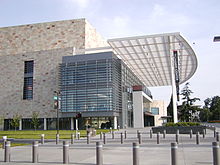
UC Davis academic spectrum is world-renowned in the arts, humanities, life sciences, health sciences, and engineering. The university has a world-class medical center in downtown Sacramento. The university also has a Department of Viticulture and Enology (concerning the scientific study of grape-growing and winemaking) that has been and continues to be responsible for significant advancements in winemaking utilized by many Californian wineries. The campus is noted for its Agricultural and Resource Economics programs, and the large Department of Animal Science through which students can study at the university's own on-campus dairy, meat-processing plant, equestrian facility, and experimental farm. Students of Environmental Horticulture and other botanical sciences have many acres of campus farmland and the University of California, Davis, Arboretum at their disposal. The university also has world-class faculty in the arts and letters and a large and diverse College of Engineering. The Department of Applied Science was founded and formerly chaired by physicist Edward Teller. Studio arts, theatre, and dance are studied extensively on the campus, and the Mondavi Center for the Performing Arts features artists from all over the globe.
UC Davis has an excellent reputation in graduate studies and has several professional schools: UC Davis Graduate Studies, Graduate School of Management, School of Education, School of Law, School of Medicine, School of Nursing, and School of Veterinary Medicine.
The university is also host to the largest Army Reserve Officer Training Corps (ROTC) program in California, with more than 120 cadets. With more than sixty years in existence, it currently commissions roughly 30 to 40 graduating seniors as second lieutenants every year.[7]
Colleges and schools
UC Davis is organized into the following schools and colleges:[8]

- Betty Irene Moore School of Nursing
- UC Davis College of Agricultural and Environmental Sciences
- UC Davis College of Biological Sciences
- UC Davis College of Engineering
- UC Davis College of Letters and Science
- UC Davis Graduate School of Management
- UC Davis School of Education
- UC Davis School of Law
- UC Davis School of Medicine
- UC Davis School of Veterinary Medicine
Library
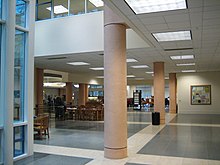
The UC Davis University Library, which includes the Peter J. Shields Library, the Physical Sciences & Engineering Library, the Carlson Health Sciences Library, and the Medical Center Library in Sacramento, contains more than 3.5 million volumes and offers a number of special collections and services for undergraduates and graduates alike. The Peter J. Shields Library is a vast building with three different architectural styles due to various construction and extensions being added; it is the main library where students study on-campus, with a 24-hour reading room, open computer labs, and unique furniture.
Research
According to the National Science Foundation, UC Davis spent $456,653,000 on research and development in the fiscal year 2002-2003, ranking it 14th in the nation. Specifically, UC Davis's expenditures nationally ranked first in agricultural research ($25,683,000), seventh in biological research ($118,477,000), and 13th in the life sciences ($336,796,000).
Its faculty includes 18 members of the National Academy of Sciences, 6 members of the National Academy of Engineering, 7 members of the American Academy of Arts and Sciences, 2 Pulitzer Prize winners, 2 MacArthur Fellows and one member of the Royal Society.
The campus supports a number of research centers including: the Information Center for the Environment, the Center for Visual Sciences, the Advanced Highway Maintenance Construction Technology Research Laboratory, the MIND Institute, the University of California Pavement Research Center, among others. The campus maintains a web site that publishes information and supports discussion about its research activities.
UC Davis is also one of 62 members in the prestigious Association of American Universities (as of 1996). The Association of American Universities is an organization of leading research universities devoted to maintaining a strong system of academic research and education. It consists of sixty universities in the United States (both public and private) and two universities in Canada.
Rankings
| Academic rankings | |
|---|---|
| National | |
| U.S. News & World Report[9] | 44th |
| Global | |
| ARWU[10] | 43rd |
| THE[11] | 89th |
In terms of Graduate Studies rankings, in 2006 U.S. News & World Report placed UC Davis First Nationally in Ecology and Evolution.
In 2008 U.S. News and World Report ranked UC Davis as the 10th best public university in the United States, and the 4th best of the UC schools (after UC Berkeley, UCLA, and UCSD).[12]
The Washington Monthly ranked UC Davis 8th in its 2007 National College Ranking.[13]
In 2008, UC Davis was ranked 42nd in the world and 34th in the Americas by an annual listing of the Top 500 World Universities[14] published by the Institute of Higher Education in Shanghai, China.
In 2007, UC Davis was ranked 96th in the world by 2007 The Times Higher Education Supplement Rankings.[15]
As of January 2008, UC Davis was ranked 42nd among the top 4000 universities in the world by the Webometrics Ranking of World Universities, which bases its rankings on a quantitative analysis of internet content specially related to the generation and communication of scientific knowledge.[16]
Admissions
Admission to UC Davis is rated as "more selective" by U.S. News and World Report.[17] For Fall 2008, 21,256 freshmen were admitted out of an application pool of 40,568 for a freshman acceptance rate of 52.4%. On average, admitted students earned a high school GPA of 3.94.[18]
Between 2007 and 2008, UC Davis saw the largest increase in freshman applicants out of all UC campuses - from 35,088 to 42,311, a 20.6% increase.[19]
31% of admitted students receive federal Pell grants.[20]
Student life
Athletics
The UC Davis Aggies (or Ags) compete in NCAA Division I sports in the Big West Conference. For football, the Aggies compete in Division I FCS (formerly known as Division I-AA), and are members of the Great West Conference, granting UC Davis the distinction of being one of only three UC campuses to field a football team (Cal and UCLA being the other two). The Aggies are also members of the Mountain Pacific Sports Federation in gymnastics and lacrosse, the Western Intercollegiate Rowing Association in rowing, and an associate member of the Pacific Ten Conference in wrestling.
The Aggies finished first in NCAA Division II six times in 2003 and won the NACDA Director's Cup 4 years in a row from 1999 to 2003. In 1998, the UC Davis men's basketball team won the NCAA Division II national championship despite being one of the few non-scholarship institutions in Division II at that time. They have also won NCAA Division II championships in Softball(2003), Men's Tennis(1992), and Women's Tennis(1990, 1993). These and other achievements motivated a decision (following a year of heavy discussion by campus administrators, faculty, staff, students, alumni and the local community) in 2003 for the athletics program to re-classify to Division I.[21][22]

The highlight of the recent 4-year transition to Division I occurred on September 17, 2005, when the Aggies defeated the heavily favored Stanford Cardinal at Stanford Stadium by a score of 20-17 on a TD pass with 8 seconds left in the game. The Aggies also pulled off an upset against Stanford in basketball just months later, beating the Cardinal 64-58 with a late rally at home on December 4, 2005. The win in these two major sports and the addition of the Aggies beating the Cardinal in soccer earlier in 2005 as well as a win in wrestling and two wins in baseball pulled the Aggies' win loss record with Stanford to 5-1 for men's sports the 05-06 year.
The Aggie football team plays Sacramento State in the annual Causeway Classic for the Causeway Carriage. The team also plays Cal Poly in the annual Battle for the Golden Horseshoe for the Golden Horseshoe (trophy). UC Davis students gather at sporting events to rally as the Aggie Pack, the largest student-run school spirit organization in the United States. The Aggie Pack cheers on the sports team to the music of the Cal Aggie Marching Band-uh! and its alumni band. Aggie Stadium is the home of the UC Davis football and lacrosse teams.
The UC Davis Women's rugby was ranked 4th in the nation in 2007.
UC Davis also has a note-worthy wrestling program, which competes in the Pac-10 at the Division I level. In 2007, UC Davis wrestler Derek Moore gained All-American status, as well as won the NCAA Division I Championships for his weight class. In addition, he received the "Most Outstanding Wrestler" award of the NCAA tournament. In so doing, Derek Moore became the first UC Davis student-athlete to become a NCAA champion at the Division I level. That same year, UC Davis finished within the top 25 for Division I collegiate wrestling programs in the country.
The official school colors are blue and gold. The blue is due to the UC's early connection to Yale[23] and as a result is often referred to as "Yale Blue" (e.g., see [1] and [2]), although UCD's official blue, usually called "Aggie Blue", Pantone 295[24] differs from Yale Blue (approximately Pantone 289[25]).
The official school mascot is the mustang. Students at UC Davis are referred to as Aggies in honor of the school's agricultural heritage. Unlike most colleges, there is a distinction between the name for students and the mascot. There was a movement to change the school's mascot from the mustang to the cow, but despite student support this was turned down after opposition from alumni. Many people will call the mustang mascot of UC Davis an Aggie, but this is not its proper name; the mustang mascot is named Gunrock. The name dates to 1921 when the US Army brought a horse named Gun Rock to UC Davis to supply high-quality stock for cavalry horses. The mustang mascot was selected to honor that cavalry horse.
School songs

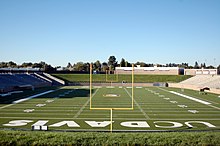

|
Aggie Fight |
Sons of California |
|
Big "C" |
|
Hail to California |
Traditions and student activities
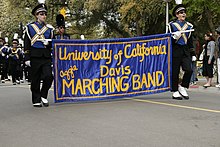
Picnic Day, UC Davis's annual Open House, is the largest student-run event in the United States. It attracts thousands of visitors each year with its many attractions. These include a parade, a magic show performed by the chemistry department, the Doxie Derby (dachshund races), film screenings, and a Battle of the Bands between the Band-uh! and other college bands including the Cal Band, the Stanford Band, and the Humboldt State Marching Band.
Another highlight of UC Davis is its student-run freeform radio station, KDVS. The station began operations on February 1, 1964 from the laundry room of the all-male dormitory Beckett Hall. The station soon gained a reputation by airing interviews with Angela Davis and a live call-in show with then California Governor Ronald Reagan in 1969. The station can now be heard on 90.3 FM and online at its website [3].
The undergraduate student government of UC Davis is the Associated Students of UC Davis (ASUCD), and has an annual operating budget of 9.7 million dollars, making it the highest funded student government in the United States.[26] UC Davis also has some 400 registered student organizations.
The academic Graduate Students and management students are represented by the Graduate Student Association (GSA). The Law Students are represented by Law Students Association.
One less-known student tradition occurs during the commencement ceremonies, where students toss tortillas into the air at the beginning of the ceremony. Tortillas are smuggled into the building under graduation gowns and released into the air after all the graduates have taken their seats.
The California Aggie
UC Davis also publishes a daily student newspaper, known as The California Aggie. The California Aggie was first published in 1915 as the Weekly Agricola after its approval by the Associated Student Executive Committee. At this point, UC Davis was considered the university farm, an extension of UC Berkley.[27]
Initially, the Weekly Agricola was focused on both student news and farming-related topics. Novelist Jack London was one of the first readers of the Weekly Agricola. In 1922, it was renamed to match the school's athletic name.[28]
Today, the Aggie has the largest print distribution in Yolo County, at around 12,000 copies distributed daily.
Greek life
Social fraternities and sororities have been a part of the University of California at Davis since 1923. Approximately 8% of the university's undergraduate students are involved in the school's fraternities and sororities. One sorority, Sigma Alpha Epsilon Pi, was featured during the first season of the MTV reality show "Sorority Life."
The Phi chapter of Alpha Gamma Rho was established on May 1st of 1923 at UC Davis making it the first fraternity on campus. Many campus buildings are named after alumni of Alpha Gamma Rho such as Emil Mrak (Mrak Hal, Registrar's office), Orville Thompson (Thompson Hall, Segundo student housing), and Dean De Carli (the De Carli room, 2nd floor MU), and many more. AGR Hall is located inside the Buehler Alumni / Visitor's Center and is commonly used as a conference room.
There are both national and local fraternities and sororities at UCD with diverse backgrounds and histories.[29]
Template:MultiCol National Interfraternity Conference fraternities
- Alpha Epsilon Pi ΑΕΠ (AEPi)
- Alpha Gamma Omega ΑΓΩ (AGO)
- Chi Phi XΦ
- Delta Chi ΔX
- Delta Sigma Phi ΔΣΦ
- Lambda Chi Alpha ΛXA
- Lambda Phi Epsilon ΛΦE
- Kappa Alpha Psi ΚΆΨ
- Pi Kappa Alpha ΠΚΑ (Pike)
- Phi Kappa Psi ΦKΨ
- Sigma Alpha Epsilon ΣΑΕ
- Sigma Alpha Mu ΣΑΜ (Sammy)
- Sigma Chi ΣX
- Sigma Nu ΣN
- Sigma Phi Epsilon ΣΦΕ (Sig Ep)
- Tau Kappa Epsilon TKE (Tekes)
- Theta Chi ΘX
- Theta Xi ΘΞ
| class="col-break " |
Health-Oriented Greek Organizations"
- Sigma Mu Delta ΣΜΔ
- Delta Epsilon Mu ΔΕΜ
Non-Council Affiliated Greek Letter Organizations (NC) men's fraternities
- Alpha Gamma Rho ΑΓP (AGR)
- Delta Lambda Phi ΔΛΦ
Collegiate Panhellenic sororities
- alpha Kappa Delta Phi αKΔΦ
- Alpha Chi Omega AXΩ
- Alpha Phi AΦ
- Chi Omega XΩ
- Delta Delta Delta ΔΔΔ
- Delta Gamma ΔΓ
- Kappa Alpha Theta KAΘ
- Kappa Kappa Gamma KKΓ
- Pi Beta Phi ΠBΦ
Multi-cultural fraternities and sororities
- Delta Xi Phi ΔΞΦ
- Epsilon Sigma Rho ΕΣΡ
- Lambda Sigma Gamma ΛΣΓ
- Sigma Alpha Zeta ΣΑΖ
- Chi Rho Omicron ΧΡΟ
- Chi Delta Theta
| class="col-break " |
African American Greek Letter Council
- Omega Psi Phi ΩΨΦ
- Kappa Alpha Psi KAΨ
- Sigma Gamma Rho ΣΓP
- Phi Beta Sigma ΦBΣ
- Delta Sigma ThetaΔΣΘ
- Alpha Kappa Alpha AKA
National Association of Latino Fraternal Organizations
- Gamma Zeta Alpha ΓΖΑ
- Lambda Theta Nu ΛΘΝ
- Lambda Theta Phi ΛΘΦ
- Nu Alpha Kappa NAK
- Sigma Lambda Beta ΣΛB
- Sigma Lambda Gamma ΣΛΓ
Transportation

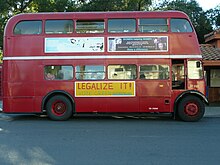
UC Davis is famous for its large number of bicycles and bicyclists. The city of Davis boasts the highest number of bikes per capita of any U.S. city. The city of Davis once held the record for the World's Largest bicycle parade. Bicyclists are ubiquitous around campus as well as the city, and thus a lot of bike-only infrastructure exists, such as bike circles, large bike lanes, and traffic signals exclusively for bikes. The police department also has some of its officers patrol on bicycles. Furthermore, the police take bicycling under the influence ("BUI") and bicycling without a headlight at night very seriously, both of which are punishable by a traffic ticket. All bikes on the UC Davis campus must be registered with a California Bicycle license.
UC Davis is also well known for its bus service, Unitrans, and its trademark London double decker buses. It has been in operation since 1968 and is believed to be the only general purpose (non-sightseeing) transit system in the U.S. to operate vintage double deck buses in daily service. The system is operated and managed entirely by students and offers fixed-route transportation throughout the city. There is also an inter-campus bus service that ferries back and forth between UC Davis and UC Berkeley twice daily, from Monday to Friday.
UC Davis is bounded by freeways on two sides (Highway 113 and Interstate 80). All other UC campuses are either somewhat distant from the closest freeway or are directly adjacent to only one freeway. Two freeway exits are entirely within UCD's boundaries. One, off Highway 113, is signed "UC Davis / Hutchison Drive" and the other, off Interstate 80, is signed exclusively as "UC Davis."
Easy freeway access, coupled with increasing housing costs in the city of Davis, have led to increased numbers of students commuting via automobile. Some students choose to live in the neighboring communities of Sacramento, Dixon or Woodland, and use their own cars or the county-wide Yolobus to get to UC Davis.
Notable people at UC Davis
See also
References
- ^ "UC Annual Endowment Report, Fiscal Year Ended June 30, 2007" (PDF). Office of the Treasurer of the Regents of the University of California. 2008. Retrieved 2008-03-28.
- ^ a b "UC Davis Student Population Headcount, Fall 1996-2006". UC Davis News & Information.
{{cite web}}: Unknown parameter|accessmonthday=ignored (help); Unknown parameter|accessyear=ignored (|access-date=suggested) (help) - ^ "The Washington Monthly College Rankings" (PDF).
{{cite web}}: Unknown parameter|accessmonthday=ignored (help); Unknown parameter|accessyear=ignored (|access-date=suggested) (help) - ^ "USNews.com: America's Best Colleges 2009: National Universities: Top Schools". U.S. News & World Report.
- ^ ["http://www.jbhe.com/news_views/49_blackenrollment_publicivies.html" "Comparing Black Enrollments at the Public Ivies"]. The Journal of Blacks in Higher Education. Retrieved November 1.
{{cite web}}: Check|url=value (help); Check date values in:|accessdate=(help); Unknown parameter|accessyear=ignored (|access-date=suggested) (help) - ^ "They're egg-cellent!". The California Aggie.
{{cite web}}: Unknown parameter|accessmonthday=ignored (help); Unknown parameter|accessyear=ignored (|access-date=suggested) (help) - ^ "Features of Volume 24, Number 4". UC Davis Magazine Online.
{{cite web}}: Unknown parameter|accessmonthday=ignored (help); Unknown parameter|accessyear=ignored (|access-date=suggested) (help) - ^ "UC Davis Academics". UC Davis Site.
{{cite web}}: Unknown parameter|accessmonthday=ignored (help); Unknown parameter|accessyear=ignored (|access-date=suggested) (help) - ^ "2023-2024 Best National Universities". U.S. News & World Report. Retrieved September 22, 2023.
- ^ "ShanghaiRanking's 2023 Academic Ranking of World Universities". Shanghai Ranking Consultancy. Retrieved February 10, 2024.
- ^ "World University Rankings 2024". Times Higher Education. Retrieved September 27, 2023.
- ^ "America's Best Colleges". U.S. News and World Report. 2008.
- ^ "The Washington Monthly College Rankings" (PDF).
{{cite web}}: Unknown parameter|accessmonthday=ignored (help); Unknown parameter|accessyear=ignored (|access-date=suggested) (help) - ^ "ARWU2007-Top 500 World Universities". Institute of Higher Education in Shanghai, China.
{{cite web}}: Unknown parameter|accessmonthday=ignored (help); Unknown parameter|accessyear=ignored (|access-date=suggested) (help) - ^ "QS Top Universities: Top 100 universities".
{{cite web}}: Unknown parameter|accessmonthday=ignored (help); Unknown parameter|accessyear=ignored (|access-date=suggested) (help) - ^ "Webometrics Ranking of World Universities".
{{cite web}}: Unknown parameter|accessmonthday=ignored (help); Unknown parameter|accessyear=ignored (|access-date=suggested) (help) - ^ "University of California-Davis at a glance". U.S. News and World Report. 2008. Retrieved 2008-05-06.
- ^ "Admission at UC Davis More Competitive for Fall 2008". UC Davis News & Information.
{{cite web}}: Unknown parameter|accessmonthday=ignored (help); Unknown parameter|accessyear=ignored (|access-date=suggested) (help) - ^ "UC Davis Leads UC Gains in Freshman Applications". Cal Aggie Alumni Association.
{{cite web}}: Unknown parameter|accessmonthday=ignored (help); Unknown parameter|accessyear=ignored (|access-date=suggested) (help) - ^ "Economic Diversity Among All National Universities", US News and World Report, retrieved 2007-08-10
- ^ "UC Davis Takes to NCAA Division I Playing Field". UC Davis News & Information.
{{cite web}}: Unknown parameter|accessmonthday=ignored (help); Unknown parameter|accessyear=ignored (|access-date=suggested) (help) - ^ "UC Davis Timeline: The Road to Division I". UC Davis News & Information.
{{cite web}}: Unknown parameter|accessmonthday=ignored (help); Unknown parameter|accessyear=ignored (|access-date=suggested) (help) - ^ "UC Davis Spotlight".
{{cite web}}: Unknown parameter|accessmonthday=ignored (help); Unknown parameter|accessyear=ignored (|access-date=suggested) (help) - ^ "Publication Standards". University Communications.
{{cite web}}: Unknown parameter|accessmonthday=ignored (help); Unknown parameter|accessyear=ignored (|access-date=suggested) (help) - ^ "Yale's Visual Identity: Yale Blue". Yale University.
{{cite web}}: Unknown parameter|accessmonthday=ignored (help); Unknown parameter|accessyear=ignored (|access-date=suggested) (help) - ^ "ASUCD Home Page". Associated Students of UC Davis.
{{cite web}}: Unknown parameter|accessmonthday=ignored (help); Unknown parameter|accessyear=ignored (|access-date=suggested) (help) - ^ UC Davis: Spotlight: Student news since 1915
- ^ UC Davis: Spotlight: Student news since 1915
- ^ "Greek Life". Student Programs & Activities Center, UC Davis.
{{cite web}}: Unknown parameter|accessmonthday=ignored (help); Unknown parameter|accessyear=ignored (|access-date=suggested) (help)
External links
- Official Website
- Official Graduate Studies Website
- Official Athletics Website
- Davis Wiki - Wiki for the community of Davis
- University of California, Davis at Curlie
- University of California, Davis
- University of California
- Educational institutions established in 1905
- Association of American Universities
- Great West Conference
- Land-grant universities and colleges
- Agricultural universities and colleges
- Western Association of Schools and Colleges
- Central Valley of California
- Yolo County, California


